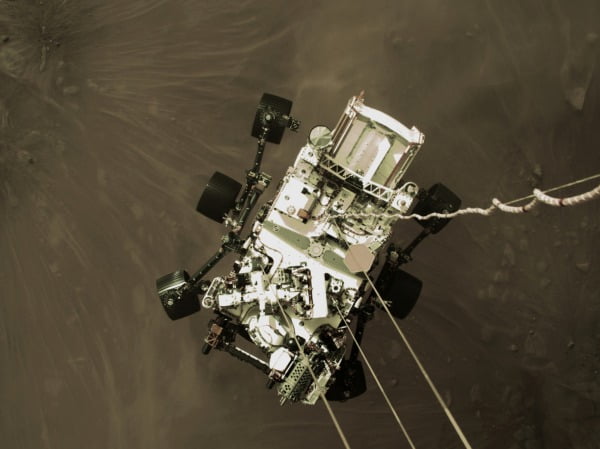
Photo = REUTERS
“This picture captured me from the air just before my wheels hit the surface of Mars.”
The US’ Mars exploration Rover Percivirence sent a picture taken while landing on Mars on the 18th. At a press conference, NASA said, “This picture is something we have never seen before. It is a symbol showing the history of mankind’s space exploration along with a photograph of the Eagle Nebula from the Hubble Telescope.
Percivirence will perform various missions for 687 days, which is equivalent to a year on Mars. The first task is to find traces of life that may have existed on Mars. In preparation for human habitation on Mars, it explores the underground space where the space base will be built with a radar that sees up to 10m underground, and conducts experiments to create oxygen from carbon dioxide in the atmosphere. The search for water to provide drinking water and fuel for astronauts is also a major task.

The image of Percivirence, an American Mars rover, photographed and transmitted the surface of Mars. Photo = REUTERS
The United States is not the only country to explore Mars. The UAE’s Amalho, which entered Mars orbit on the 10th, China’s Tianyuan 1, as well as European and Indian probes are circling Mars. In recent years, interests are expanding beyond Mars to farther space. Among them, the vast’asteroid belt’ between Mars and Jupiter is drawing attention from scientists. The largest asteroid in this realm is Ceres. With a diameter of about 900 km, it is a quarter the size of the moon (3476 km) and accounts for 30% of the total mass of the asteroid belt.
Japan was the first country to pay attention to such asteroids. The Hayabusa 2, launched in 2014, collected 0.1 g of soil from the asteroid Ryugu, which was 340 million km away from Earth at the end of last year, and sent it to Earth. Hayabusa 2 will fly 10 billion km more over the next 11 years, and will show’the flesh of the universe’ one by one.
Earlier this month, astrophysicists published a study showing that a space colony in the form of a super-satellite could float above Ceres between Mars and Jupiter. The space colony they envisioned looked like a 10 km long train. The soil was laid in it to grow trees and crops, and the atmosphere was filled so that people could live. It was predicted that 57,000 people could live here.

Mars soil photo/photo from Exploration Rover = AP
What is the reason why the researchers planned to build a colony over Ceres? This is because Ceres is rich in nitrogen, unlike Mars. Nitrogen makes up 78% of the Earth’s atmosphere and is the basis of organic matter. It is an important material that can decorate its own ecosystem without dissemination from the earth. They predicted that they could build a space elevator that connects the Ceres surface and the colony to pull up the necessary resources.
These ideas act as a trigger to accelerate space development technology. Humans’ first steps toward space also started from the imagination of a child flying in the sky. The stars and moon in the night sky are the mediums that expand the realm of dreams to infinity.
Compared to the’space powers’ in the US, Russia, China, Japan, and Europe, Korea’s space development capacity is still in its infancy. It is at the entry level in almost all areas, including space launch vehicles, satellite development, and planetary exploration. In 1992, we launched our first satellite and launched the Naro, which borrowed Russian technology in 2013, but the launch vehicle, which is essential for space exploration, cannot be made with its own technology.
The launch plan for the lunar orbit was also delayed from 2018 to 2022. The lander was further delayed to 2030. The Mars rover is being sent to the UAE, a latecomer, and the reality is that the plan changes like a rubber band and the person in charge changes every one to two years depending on the regime.
Editorial Writer Ko Doo-hyun [email protected]
